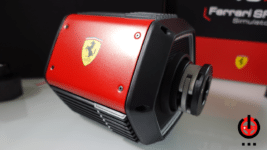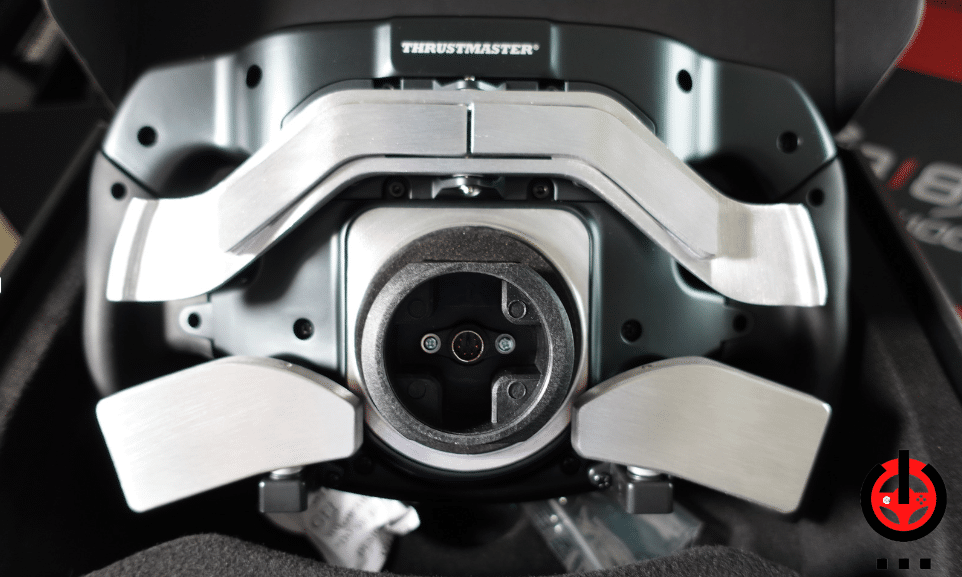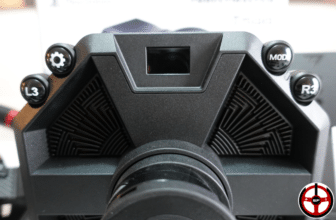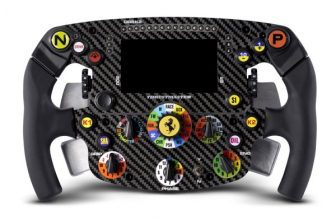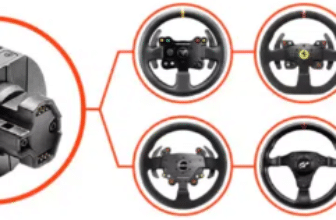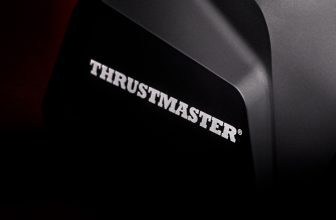The Thrustmaster T818 Ferrari Edition has one mission: to remind simracers the world over that the French brand was the leader in simracing for over a decade. And that it’s still capable of releasing equipment at the cutting edge of innovation. But is this still the case? We’ve had to wait a long time for Thrustmaster to finally offer us a Direct Drive. And a long time for us to be able to try it out.
It’s already beentwo years since the release of the Fanatec CSL DD, which forever changed the face of the simulation world. And we’ve lost count of the number of emerging brands that have launched their models in its wake.
After years of anticipation, I suppose it’s fair to say that the Thrustmaster teams have had time to study the competition in depth. So they’ve certainly come up with a model that will be able to take on all the entry-level models in the Direct Drive world. Right? (??!??)
What does the Thrustmaster T818 look like technically?
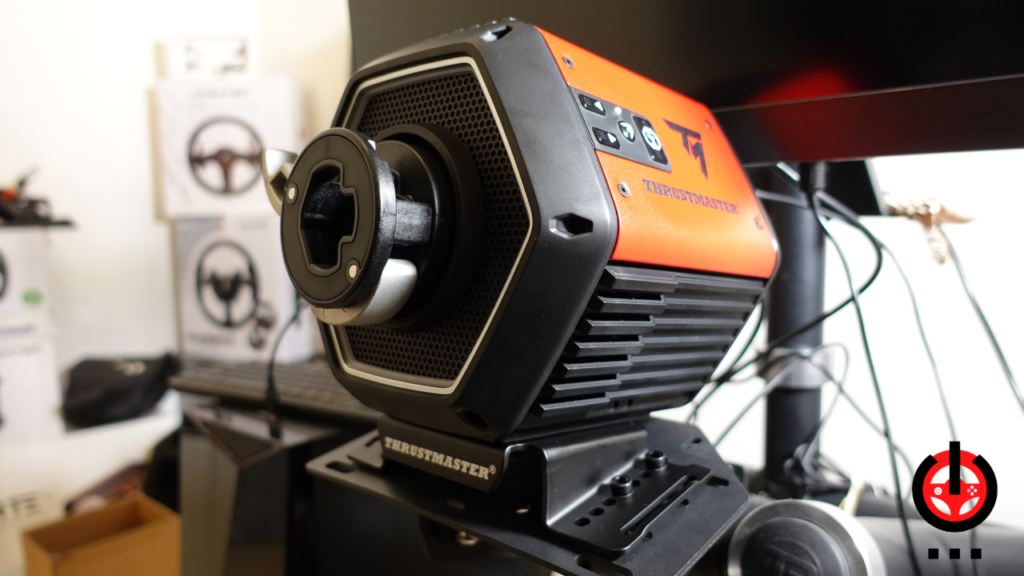
| Compatibility | PC |
| Dimensions | 22.43cm long including QR, 18.85cm high and 18.85cm wide |
| Motor | Direct Drive (stepper motor) |
| Torque | Peak: Not communicated Continuous: 10Nm constant torque Torque rise: Not communicated |
| Encoder | Not communicated |
| Turning range | 40° to 1080° adjustable via Thrustmaster software |
| Connections | 1 USB-C output to PC 1 power supply 1 Thrustmaster pedalboard connector 1 mysterious RJ45 “DIO 1 hidden connector for future products |
| Wheel mounting | Thrustmaster’s new Quick Release system |
Design and ergonomics
Right out of the box, the T818 Ferrari Edition looks pretty good. Its hexagonal shape is rather pleasing to the eye, although I grant you it’s a matter of taste.
The two upper sides feature metal plates. These plates can be changed to other colors as an option. The first, on the left, is in the Ferrari colors, with a beautiful prancing horse logo. On the right, the Thrustmaster logo is accompanied by 4 buttons.
Two buttons with in-game settings, a base and pedalset mode selection button (to switch from the GT position pedalset to the formula position pedalset, for example) and a torque cut button.
- In the box:
- Thrustmaster T818 base
- Ferrari SF1000 steering wheel
- Quick Releaseadapter
- Table clamp
- 1power supply
- 1 USB-C – USB cable
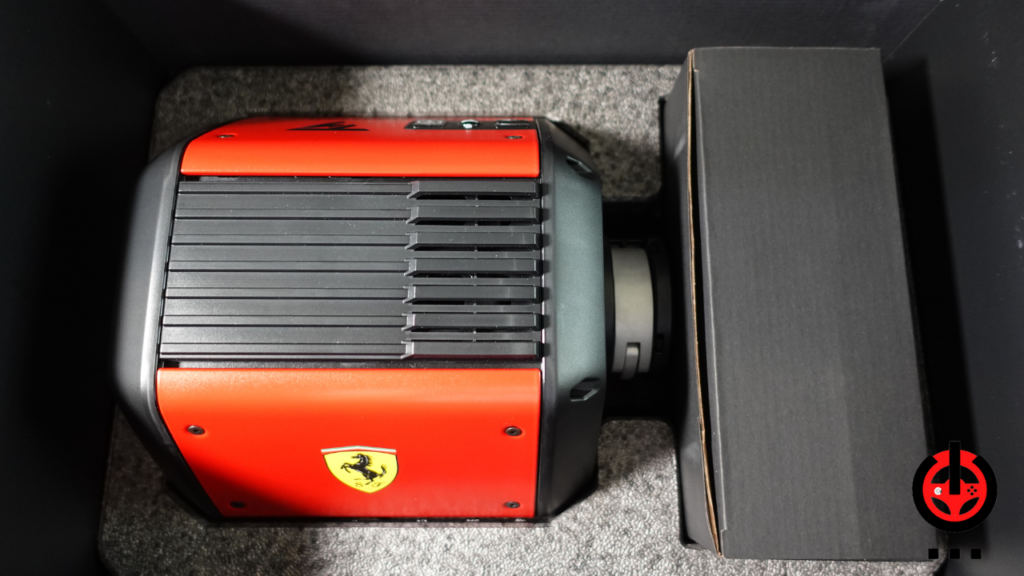
On the front, a plastic grille frames the brand’s new Quick Release. The whole thing is encircled by an LED strip that will light up our long gaming sessions. Overall, the design is very appealing.
Moving on to the rear

After so much poetry, we turn the beast around and head for the rear panel. This is where we find the connectors, which aren’t numerous, but let’s not start complaining (yet). Here I find the power supply, the USB-C socket for connecting the base to the PC, and the DIO socket, the function of which we don’t yet know (but I’ve got a pretty good idea…). A connector for connecting your Thrustmaster pedalboard, if you have one. And finally, a connector hidden under a cover (which I obviously removed later) with a mysterious function. Place your bets in the comments ^^
The ON/OFF button on the rear panel isn’t my favorite thing. Why not? Quite simply because the Thrustmaster T818 is equipped with a stepper motor that calibrates itself on each start-up. This means that when you press the button, you have to quickly move your arm out of the way so as not to interfere with the steering wheel’s calibration. But nothing dramatic.
Installing the Thrustmaster T818 on the chassis
For chassis installation, Thrustmaster has prepared a little surprise! The 4 M6 screw threads under the base no longer correspond at all to their previous models. In concrete terms, this means one simple thing: no chassis is compatible without having to drill a hole in your mounting plate or without having an adapter. More and more brands are pulling pranks like this these days. Are they making that much money on adapter sales?
- The 4 mounting options :
- 4 M6 screw threads (center distance 63mm x 79mm)
- Inclined adapter (135mm with 7 slots spaced 9.65mm apart in depth)
- Table clamp adapter (ideally placed on a solid table 25 to 40mm thick)
- Flat cockpit adapter (optional for €39.99)
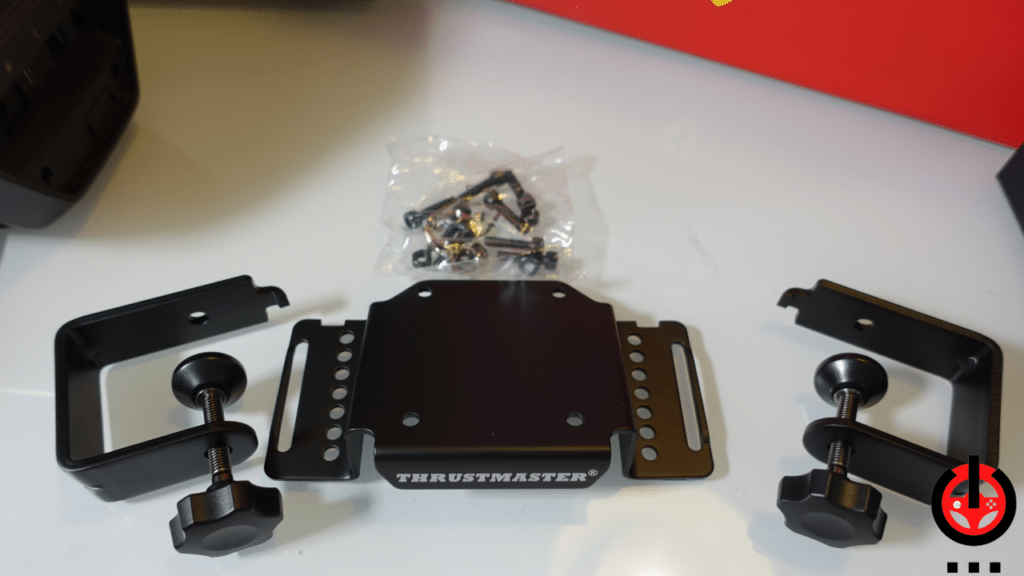
But we were delighted to discover that the adapter that doubles as a table clamp is supplied with the T818 Ferrari Edition. We couldn’t have wished for anything less! After all, buyers of the conventional T818 had to purchase it as an option. And even if the “flat” chassis adapter isn’t included, at least we’ve got a viable installation option in the box.
I’d like to dwell for a moment on the table clamp. It allows the base to be placed on a desk between 15 and 41mm thick. However, the user manual recommends desktops between 25 and 40mm thick. And in terms of rigidity, it’s very good indeed. The two clamps are made of thick metal, and having tested them on our coffee table, I can tell you that they’re very effective.
What does the new Thrustmaster Quick Release look like?
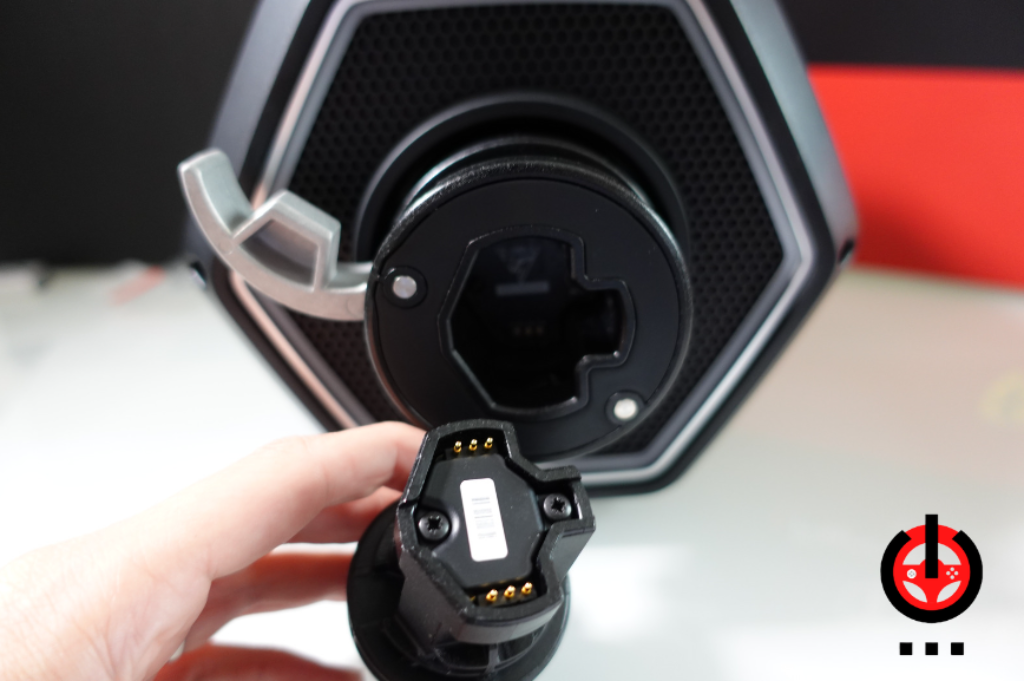
To install the steering wheel on the steering shaft, Thrustmaster has prepared a brand new Quick Release. Let me tell you, I couldn’t wait to try it out. Let’s not forget that it was the T500 model that launched the great waltz of detachable steering wheel systems at the time. A major innovation in the simracing world at the time!
But the old system was, frankly, completely outdated. There was too much flexibility, it wasn’t practical to use… In short, it was time for a change.
The Quick Release adapter for all the brand’s steering wheels
And when you say change the Quick Release, you mean you need an adapter for all the steering wheel wheels Thrustmaster has released to date. So the base comes standard with an adapter to make the whole range compatible with the new system. I install it on the SF1000 wheel. It’s pretty straightforward: just insert the adapter into the old QR, screw on the clamping ring and place the security screw in the hole provided.
Easy and practical. However, don’t expect your adapter to fit easily on your other steering wheels (if you have any). To remove it, you need to use a flathead screwdriver to pry it out of the steering wheel’s QR. It’s not easy to do, and it leaves marks on the adapter. Ideally, if you have several TM steering wheel wheels at home, you should buy other adapters which cost 34.99€. A reasonable price if you look at what other brands are charging for QRs.
First test of the QR: plastic isn’t fantastic
It’s very simple to install: unfold the metal locking lever, insert the steering wheel on the steering shaft and fold the lever down, making sure it’s all the way down. And that’s it! Not the most practical system, but not the worst either. It does the job, period.
Where I’m not happy , however, is with the flexibility of this QR. It’s very flexible. And that’s normal, since the QR is made of plastic! I end up with a lot of lateral flexibility and squeaks that let me know that the plastic parts are rubbing against each other. This is something I’ll have a chance to check when I remove the steering wheel. Its plastic QR showed slight traces of wear resulting from friction between the parts.
For me, in 2023, that shouldn’t exist.
Locked in an ecosystem again?
It’s 2023 at the time of this test, and Simracers DON’T WANT to be locked into an ecosystem again. The problem is that, with this model of Quick Release adapter, we’ll never be able to fit anything other than a Thrustmaster wheel on the T818. This was still an acceptable idea 2 years ago, but today it’s a big negative.
All the SimRacing brands, ALL of them, with the exception of Thrustmaster and Logitech, have understood that opening up to other brands of steering wheels has become a must. Especially since, let’s face it, Thrustmaster doesn’t offer any top-of-the-range steering wheels. Or at least on a par with its Direct Drive competitors. So I dare to hope that the forthcoming arrival of the Ferrari 488 GTE steering wheel will show that the brand is moving upmarket.
Settings via Thrustmaster software
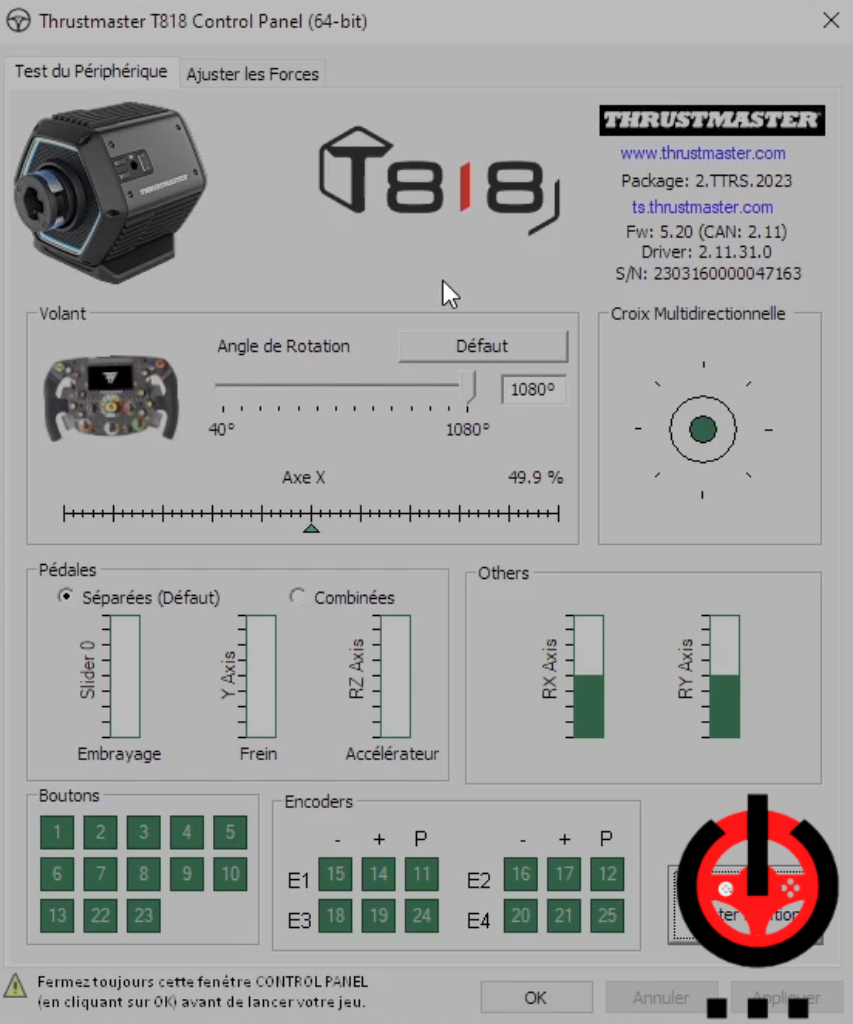
Let’s take a brief look at the software… Well, the control panel. As you can see, it’s far from standard in terms of design, but let’s move on. The first page shows the rotation angle, which can be changed from 40° to 1080°. It’s a pity we didn’t leave the player the choice of adding more rotation angles! I’m thinking, for example, of fans of truck simulators (yes, I admit I love Euro Truck Simulator 2), who will be left wanting more. Still on the first page, we have the buttons and encoders for our base and steering wheel.
On the second page, you’ll find our force feedback settings and front LED colors.
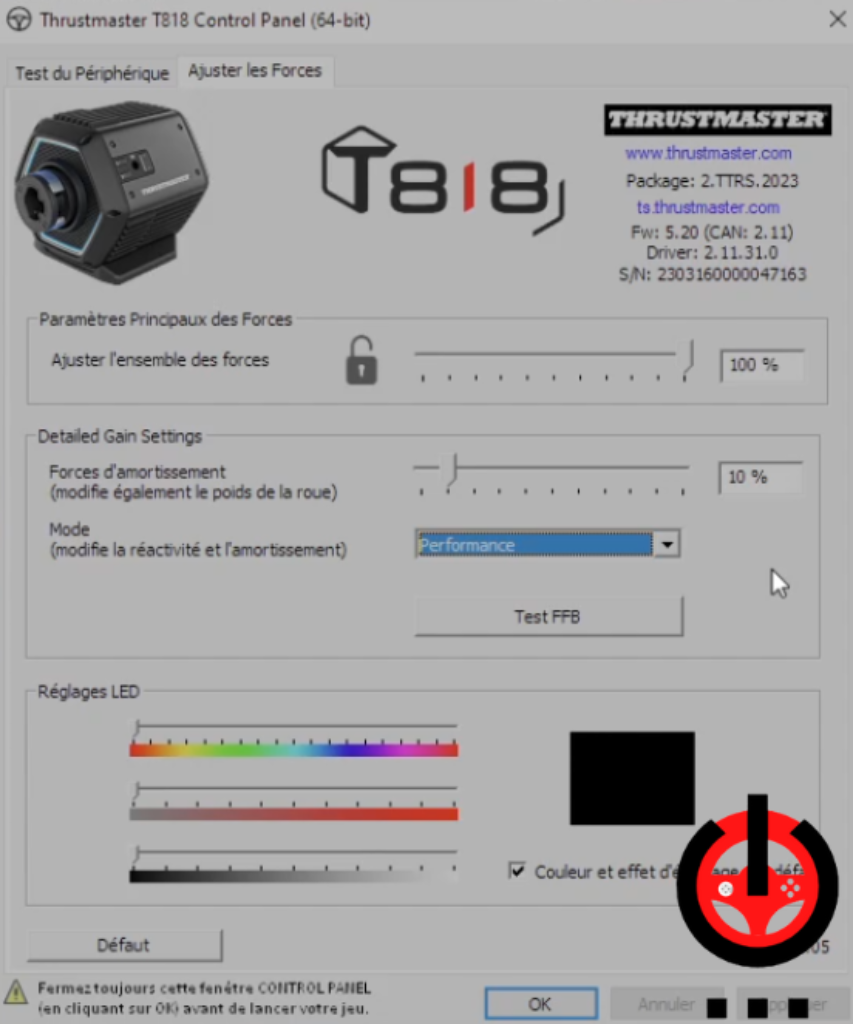
As for force feedback, I was really worried about TM. In their press releases, they claim to have chosen to filter as little as possible the force feedback sent by the games. This philosophical choice would justify the fact that the software doesn’t offer any fine-tuning of the base force feedback.
SO, instead of having access to a series of sliders that would allow us to create the exact force feedback we want, depending on the sim we’re using… We’ll have to make do with 4 presets created by Thrustmaster and a slider that allows us to add more or less damping (often also called Damper)
So here we are with 4 settings: Comfort, Sport, Performance and Extreme. The more you go for comfort, the less detail you’ll find in the force feedback. With an increasingly damped feel. And the more you go to Extreme mode, the more detail and lively movement you get. Personally, the one I liked best was performance. Balanced without being too abrupt and relatively “ok” on all simus.
Following a software update, a new cursor appeared. This is a force feedback linearity setting. And this is very good news for a simple reason: it completely eliminates the oscillations that the FFBs produce in certain games.
Don’t put it too hard or you will lose a lot of feeling in the center of the steering wheel. But an adjustment between 10 and 15% allowed me, for example, to completely eliminate the oscillations of Assetto Corsa. A feat!
Comfort and feel
At last we hit the track! This time I chose to start my runs on rFactor 2. In my opinion, this is the most detailed force feedback sim on the market today, and it’s a good way to see the limits of a base.
At the start, I was in Sport mode with 100% force feedback. In concrete terms, it lacked detail and information, so I immediately switched to performance mode. And I have to admit, the force feedback was pretty good! I found plenty of track detail and the base’s responsiveness to grip loss.
Responsiveness is the workhorse of the prancing-horse T818 (poetic, isn’t it?). And even if the brand has chosen not to communicate the figures linked to this reactivity, I’d say it’s in the upper mid-range of entry-level Direct Drive models.
Another positive point is that even when pushing the game’s power quite high, I don’t experience too much clipping. Of course, it’s always possible to have clipping, as with any base, by pushing the settings to the limit. But overall, I’m satisfied with the T818’s strength-to-detail ratio. Let’s not forget that the base doesn’t have a big motor, and its 10Nm are used intelligently.
This is the saturation point of the base force feedback. When the data sent by the game is greater than what the engine is capable of transmitting, then you no longer have the slightest detail in the force feedback but just brute force without any nuance. And you must obviously avoid that at all costs.
On the other hand, I’m less seduced by iRacing. The lack of settings on the TM software never allowed me to really create the feeling I was looking for. On Assetto, on the other hand, I was delighted to get rid of the oscillations in a way that was as effective as it was inexpensive in terms of detail.
But then again, why not allow us to go and fine-tune the base force feedback? It could be excellent!
Why restrict players?
Well, yes, it’s playable, and for someone who’s never touched a Direct Drive in their life it’ll be a joke… But for any serious gamer who knows what the competition is capable of producing, not being able to customize the force feedback is a real problem. On F1 23 it was almost perfect, but on all the other games we had to make heavy compromises. At a time when even new brands are producing “relatively efficient” software, TM’s choice is very hard to support.
Hey Bernard! Who cares about the torque cut button? We put it on to make it look good anyway!
My personal, imaginary interpretation of TM’s torque cut meeting
A Direct Drive base is powerful and can sometimes be brutal. The torque cut button allows you to quickly neutralize the base’s force feedback if the steering wheel gets out of hand. It needs to be positioned away from the steering wheel to prevent you from injuring yourself trying to activate it. You also need to be able to disengage it to quickly boost engine torque without having to restart the base. Because if you have to restart the base, in a lot of simus that means having to restart the session or the game. In an online race, it simply means giving up..
So how does this torque cutter work?
Well, you’re out of luck! To activate the one on the Thrustmaster T818, you have to pass your arm quite close to the right of your steering wheel. So there’s a good chance of getting hit in the wrist or forearm by the steering wheel. But after all, safety is for little girls… er… well. But there’s another problem: to restart the base’s torque, you have to restart it completely. So there you have it.

